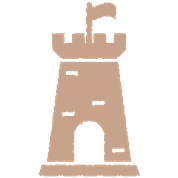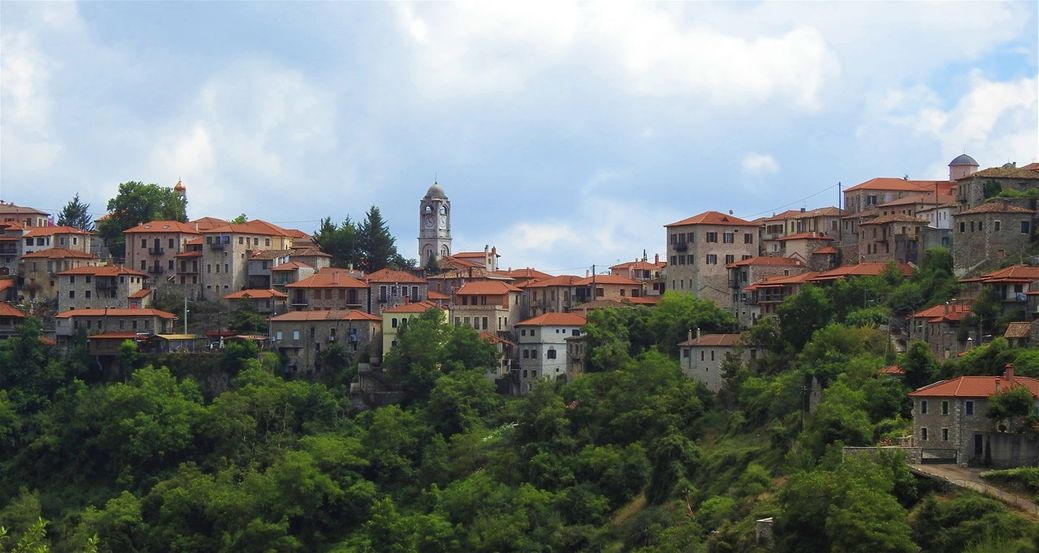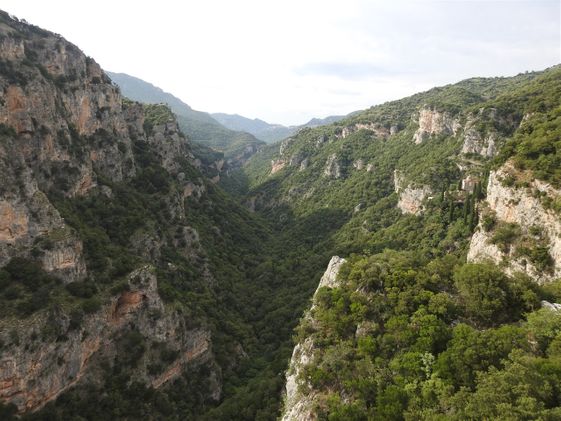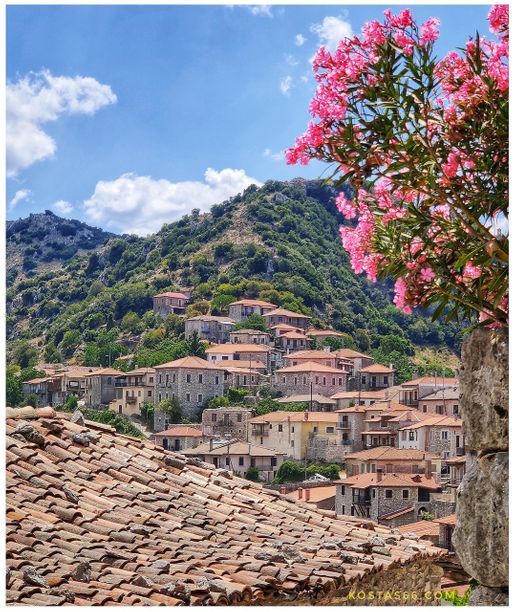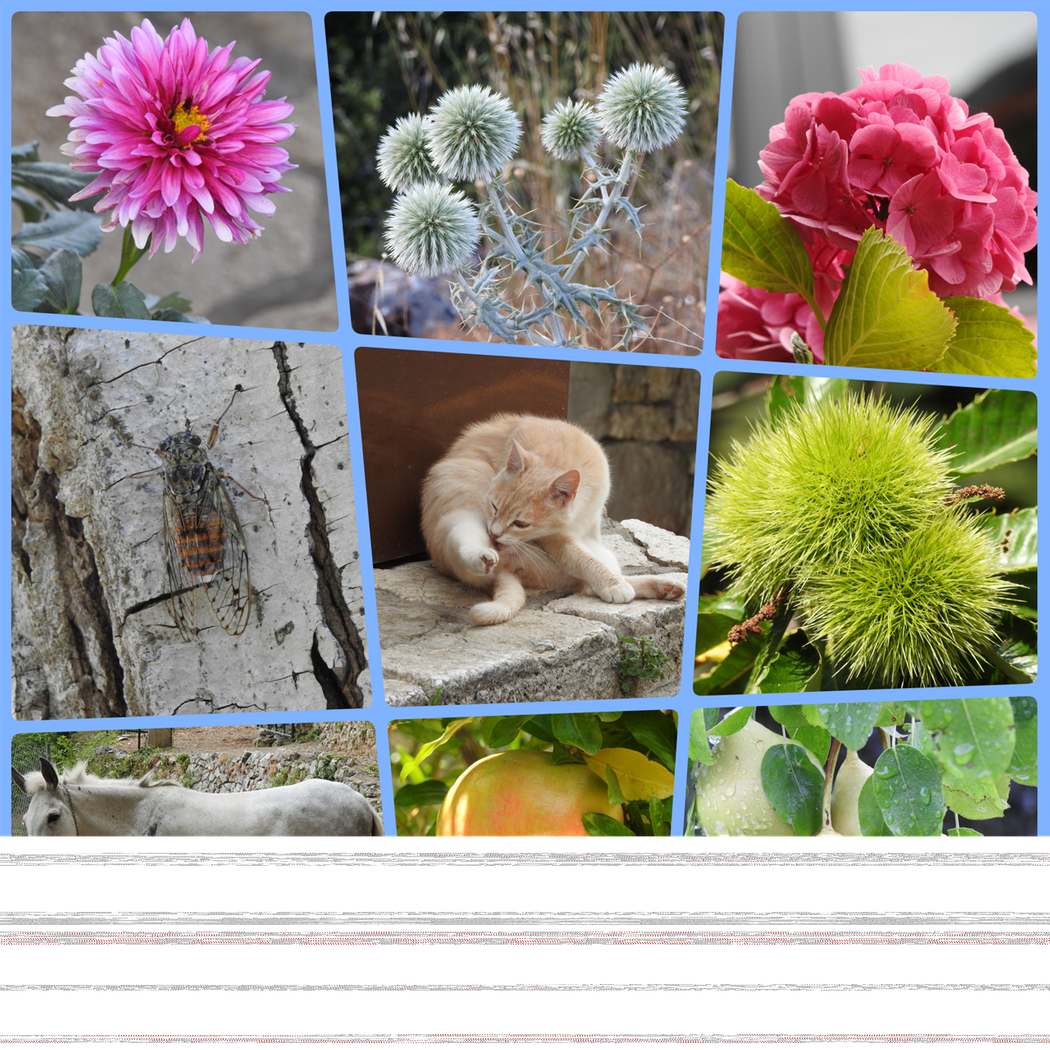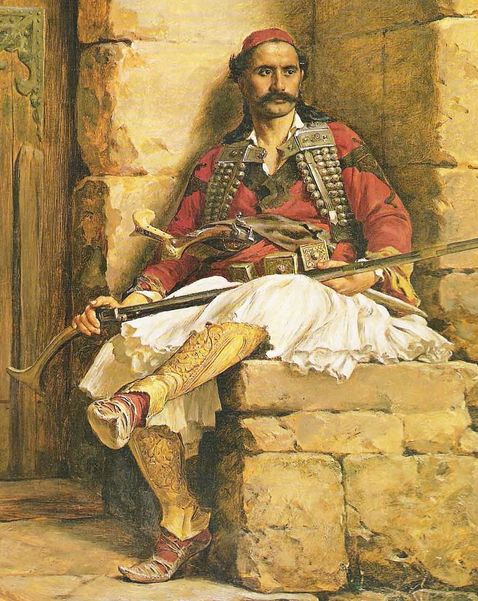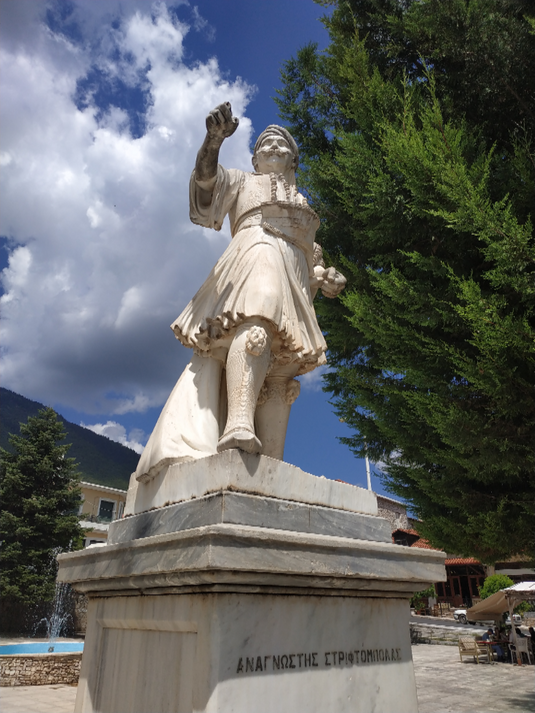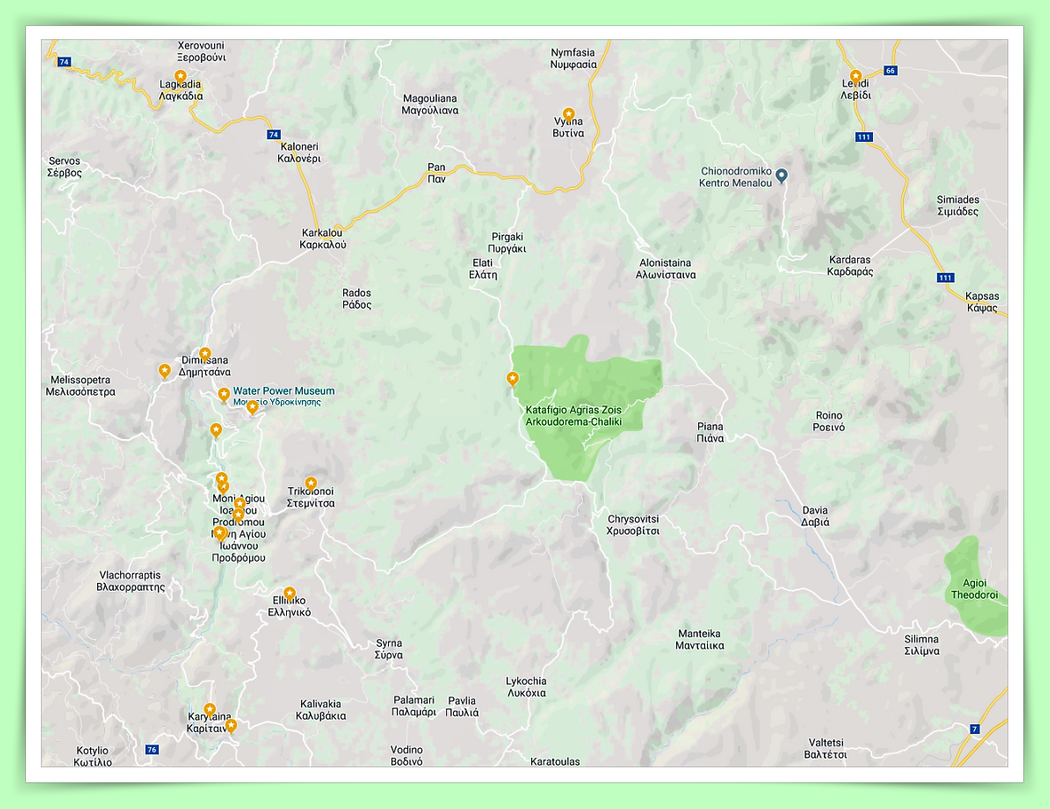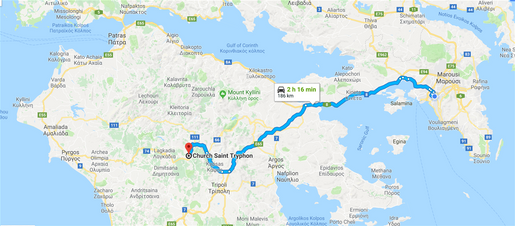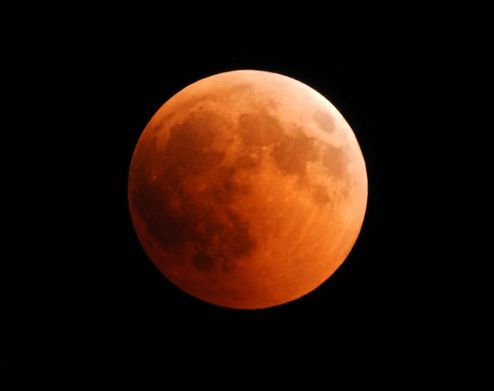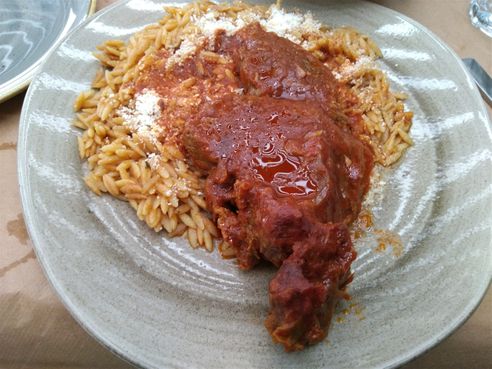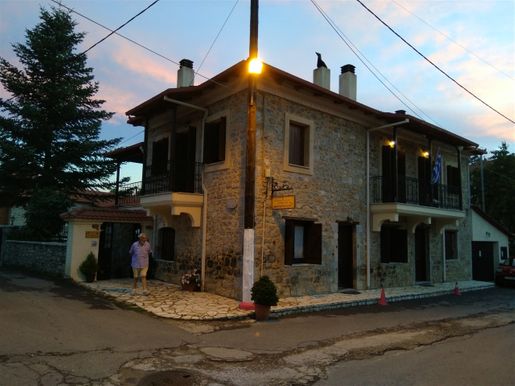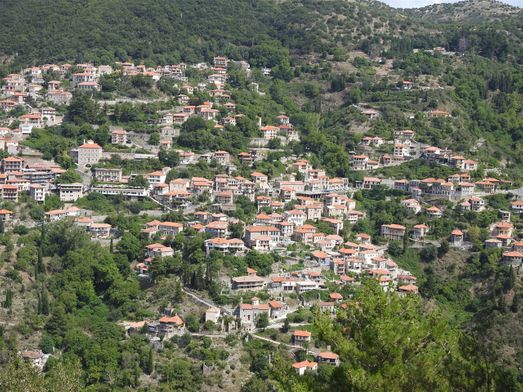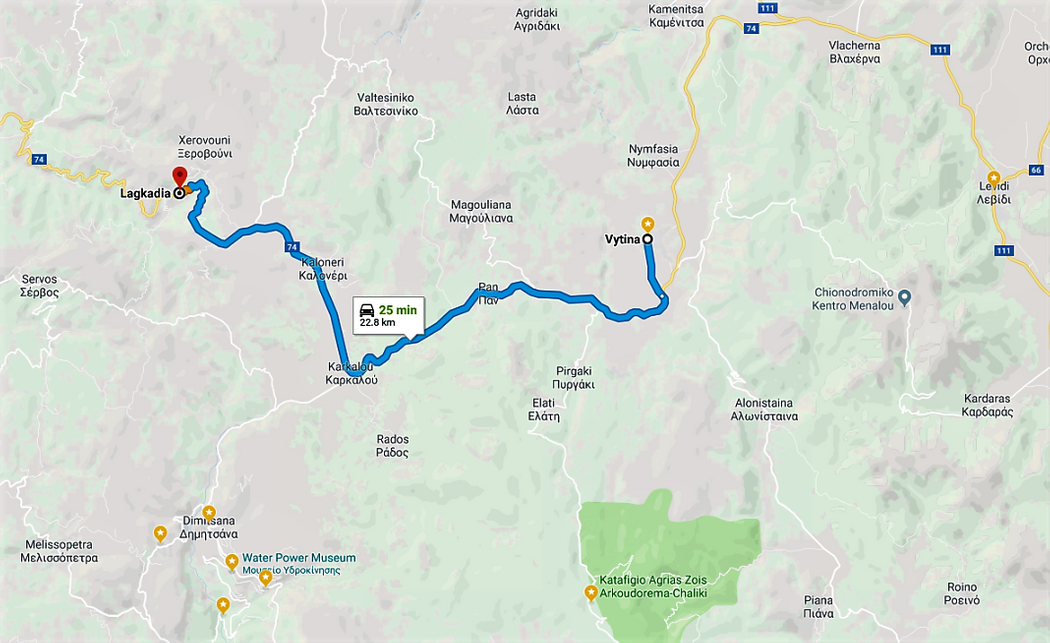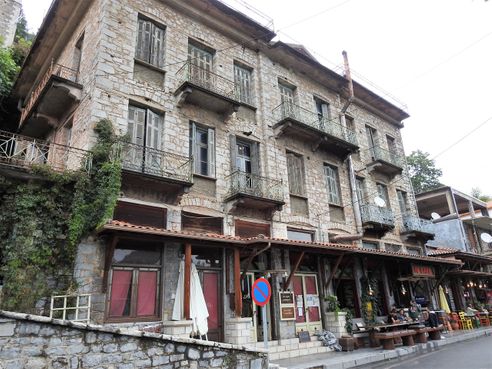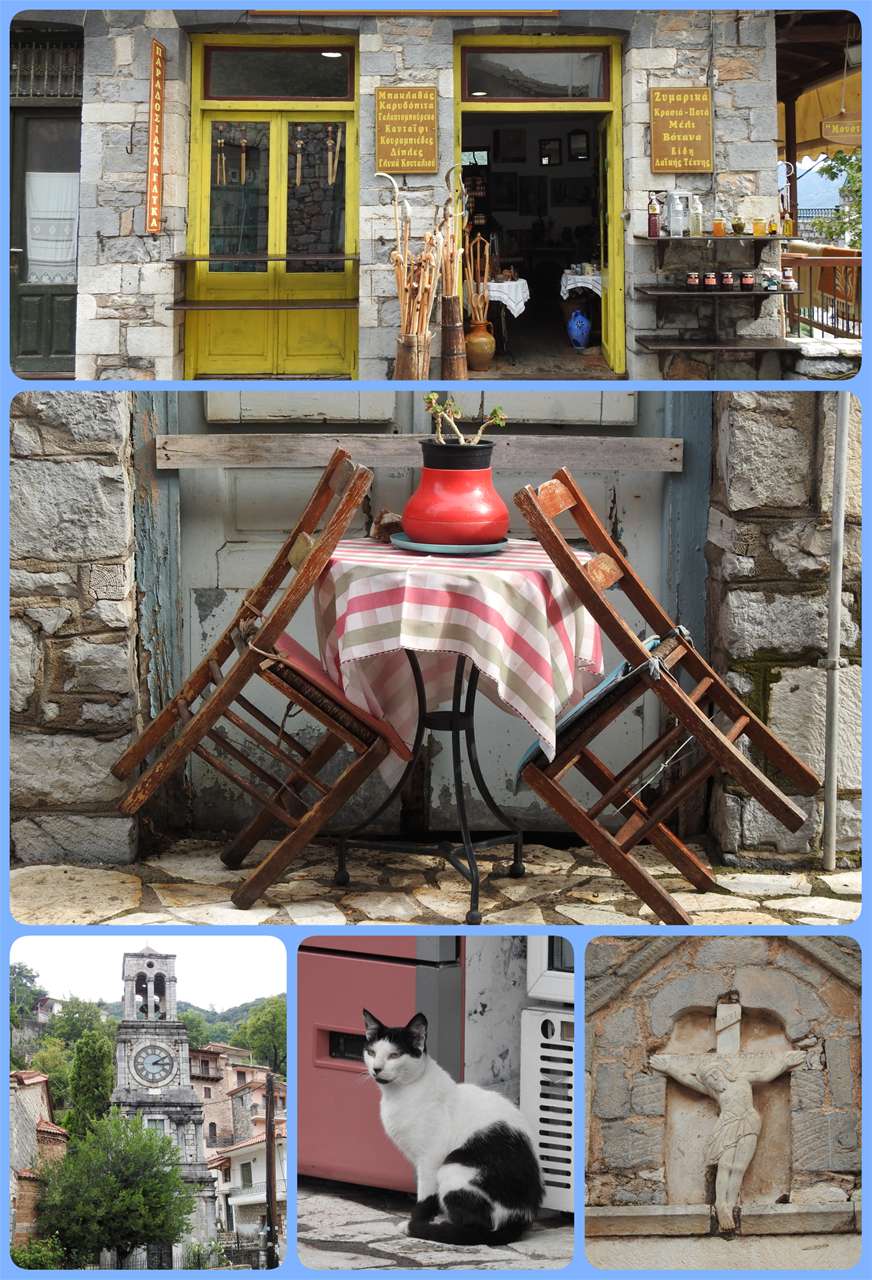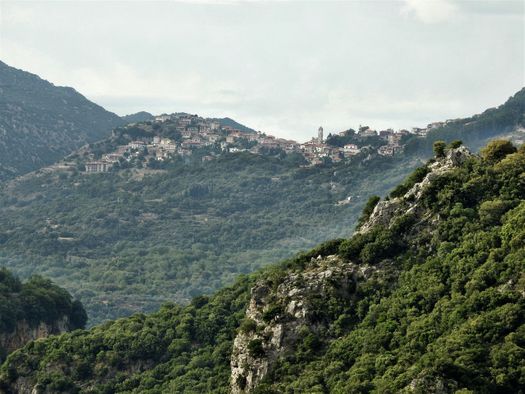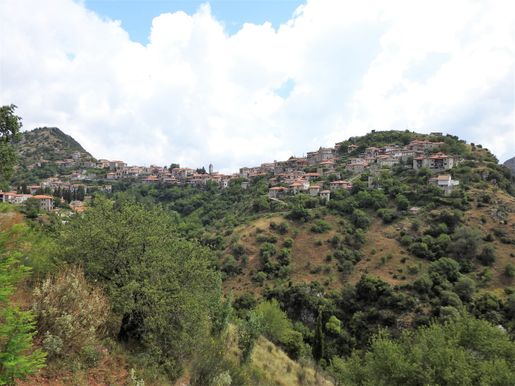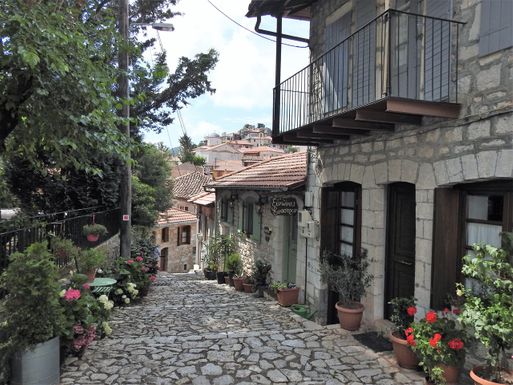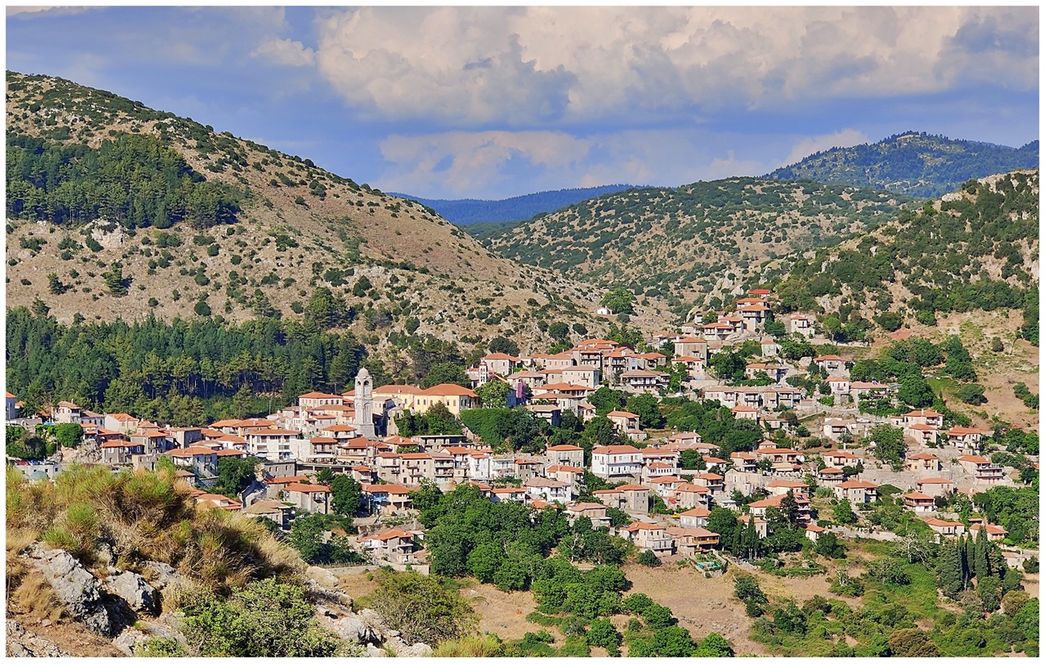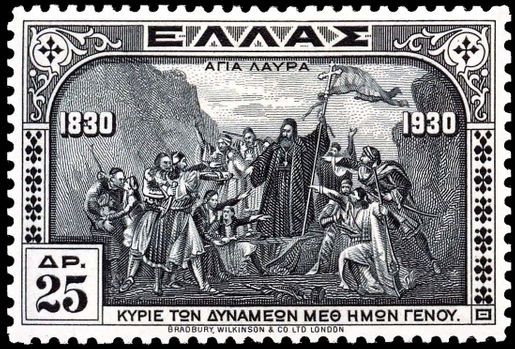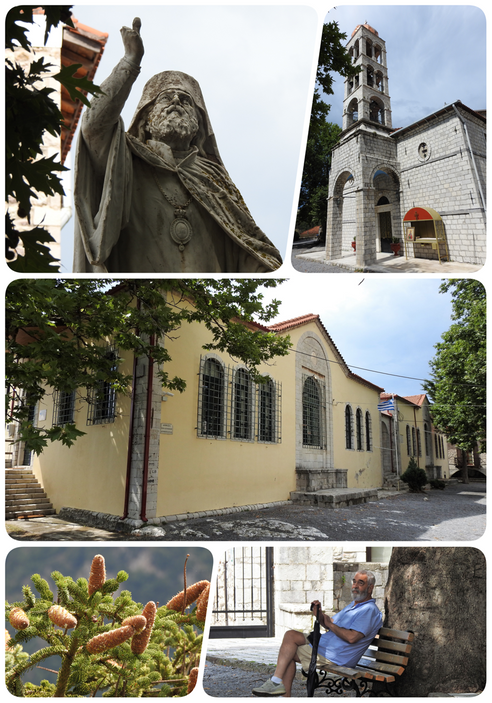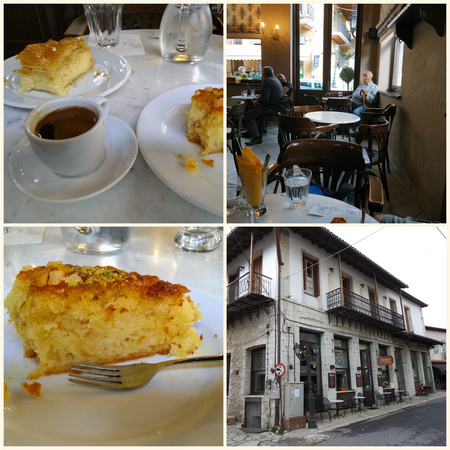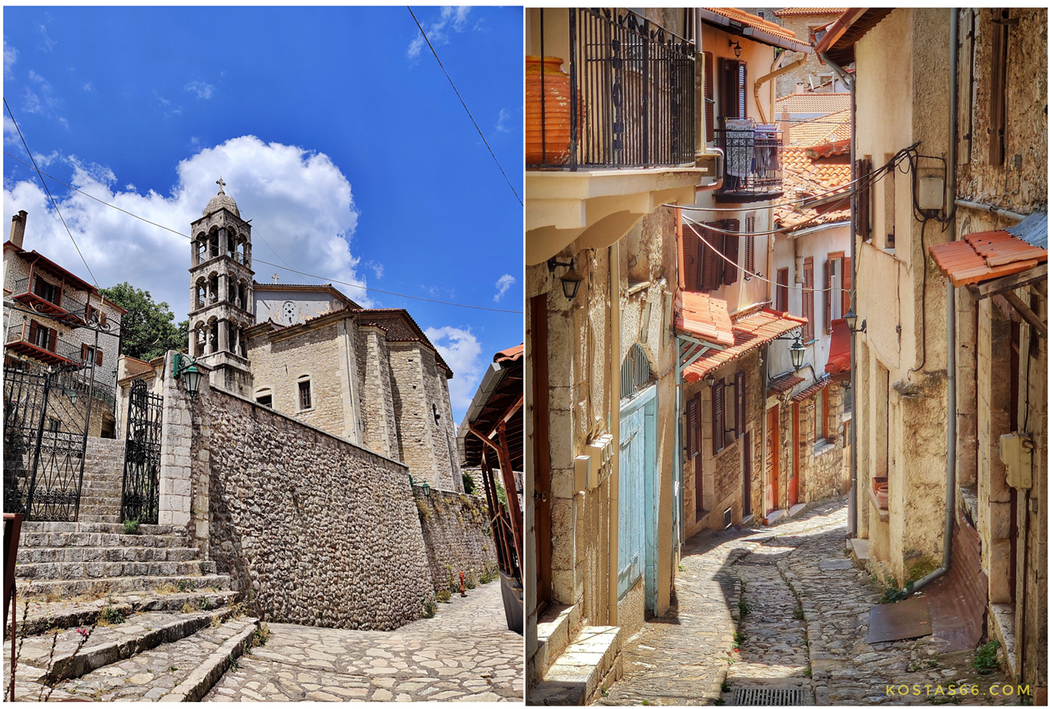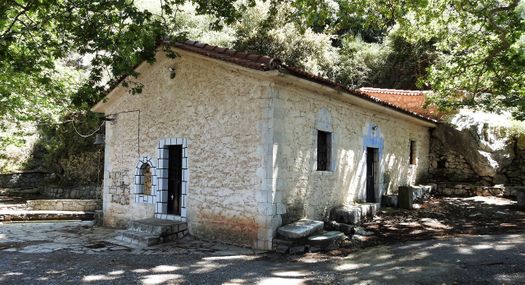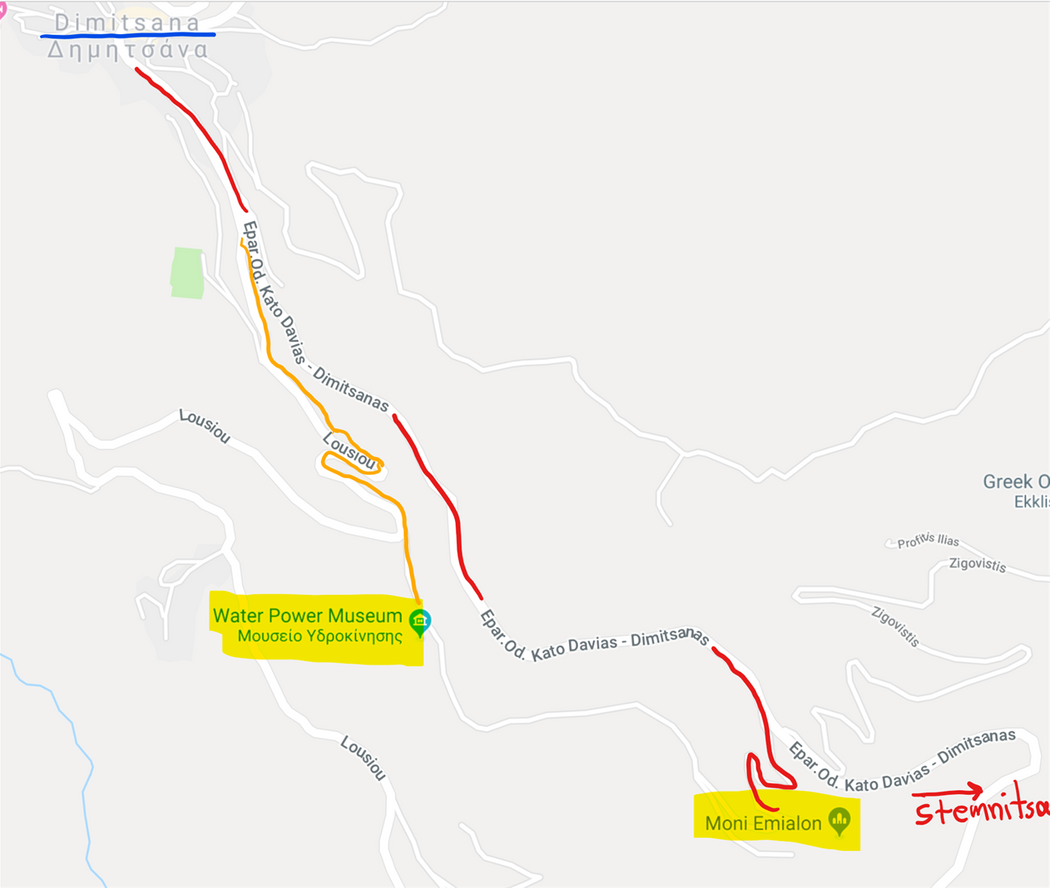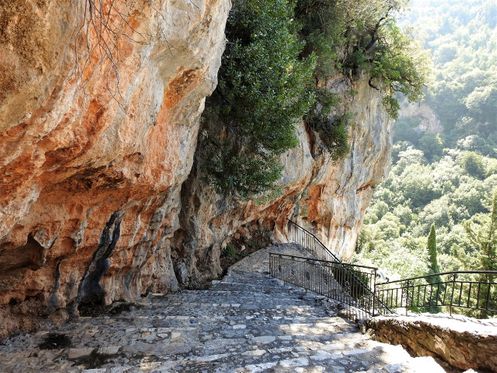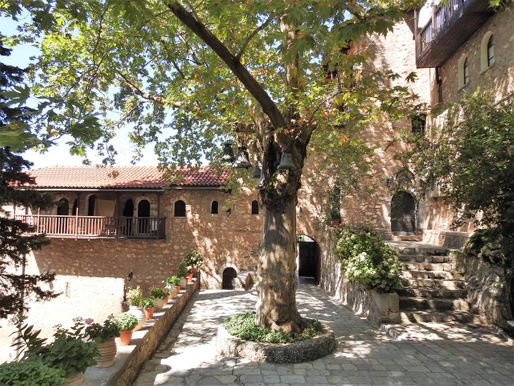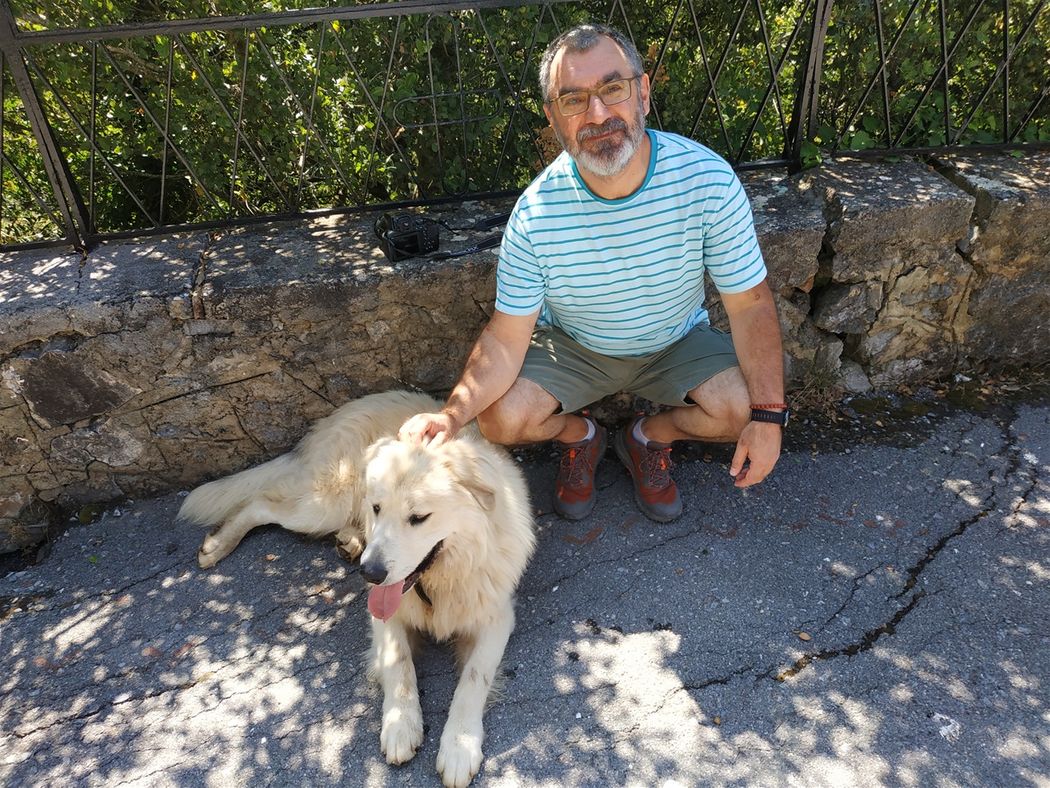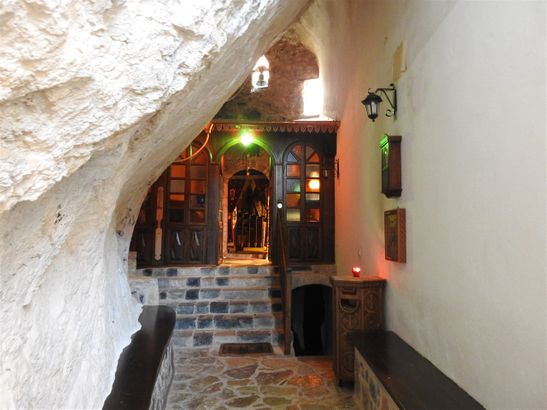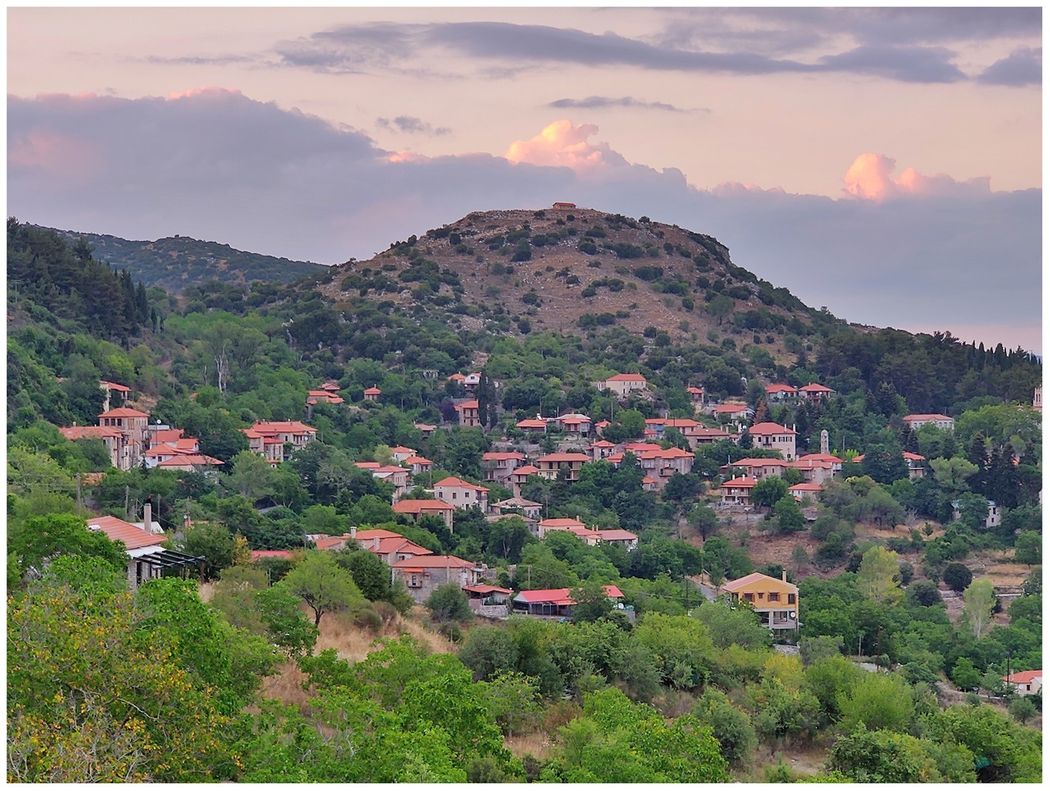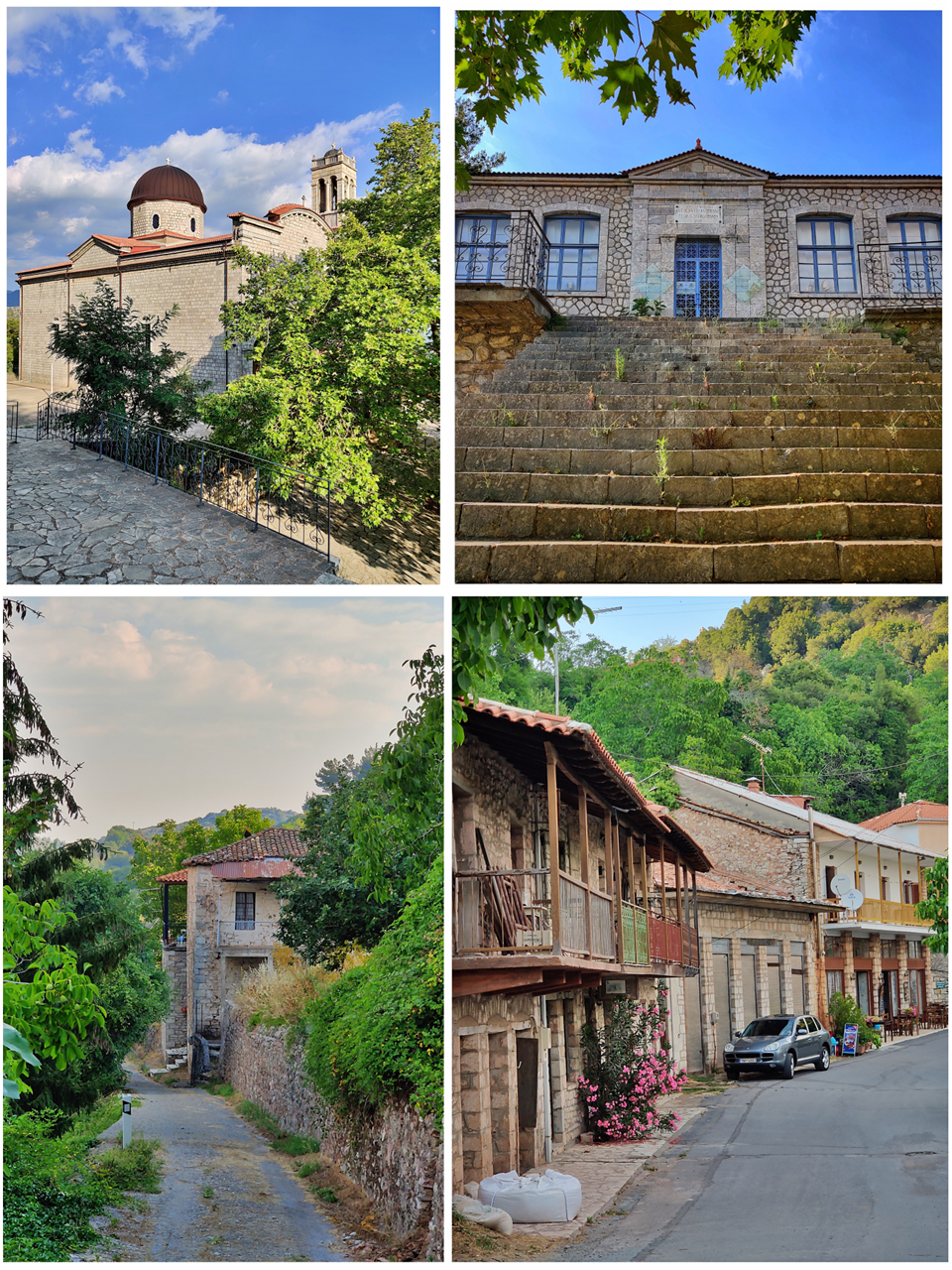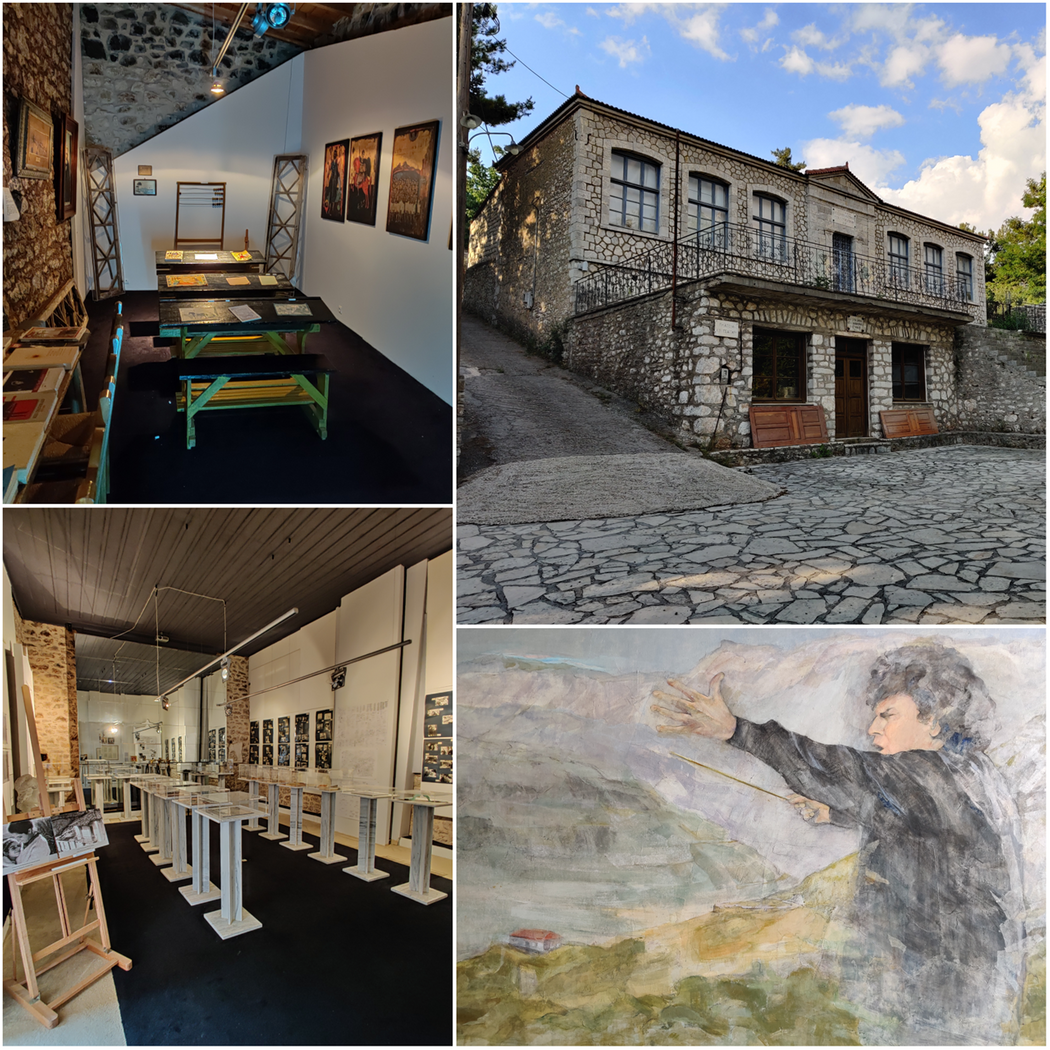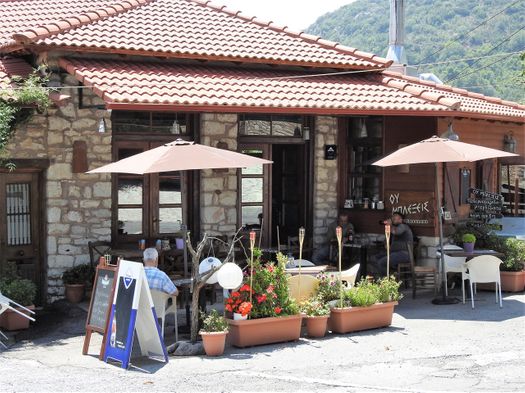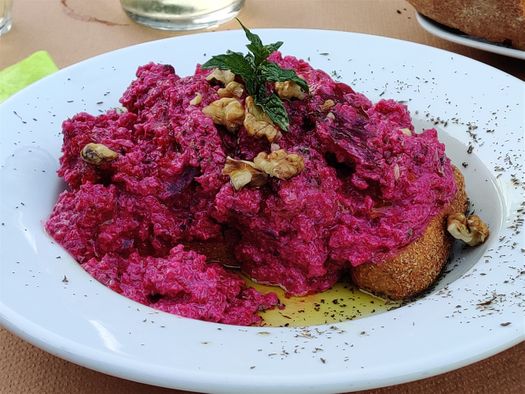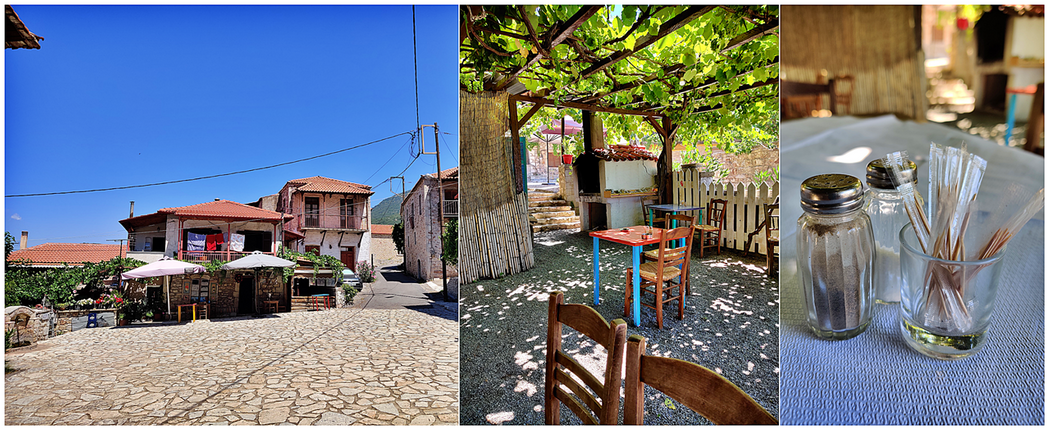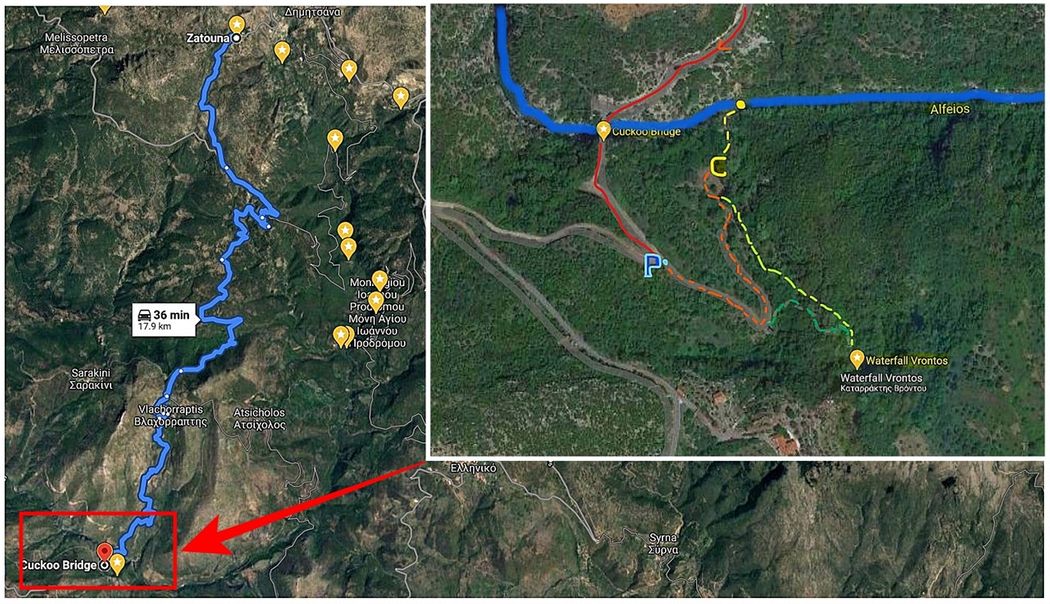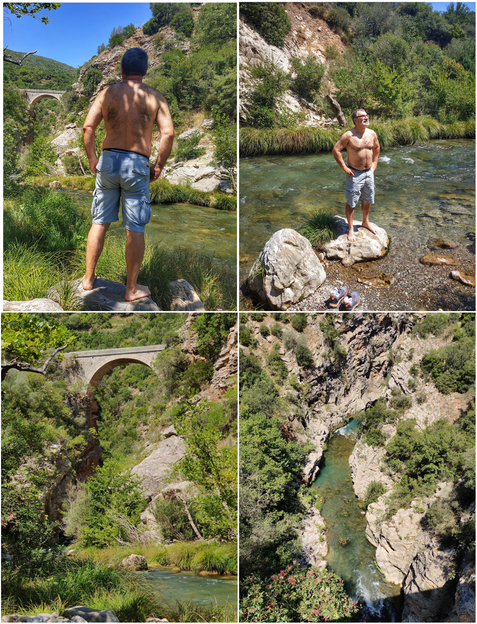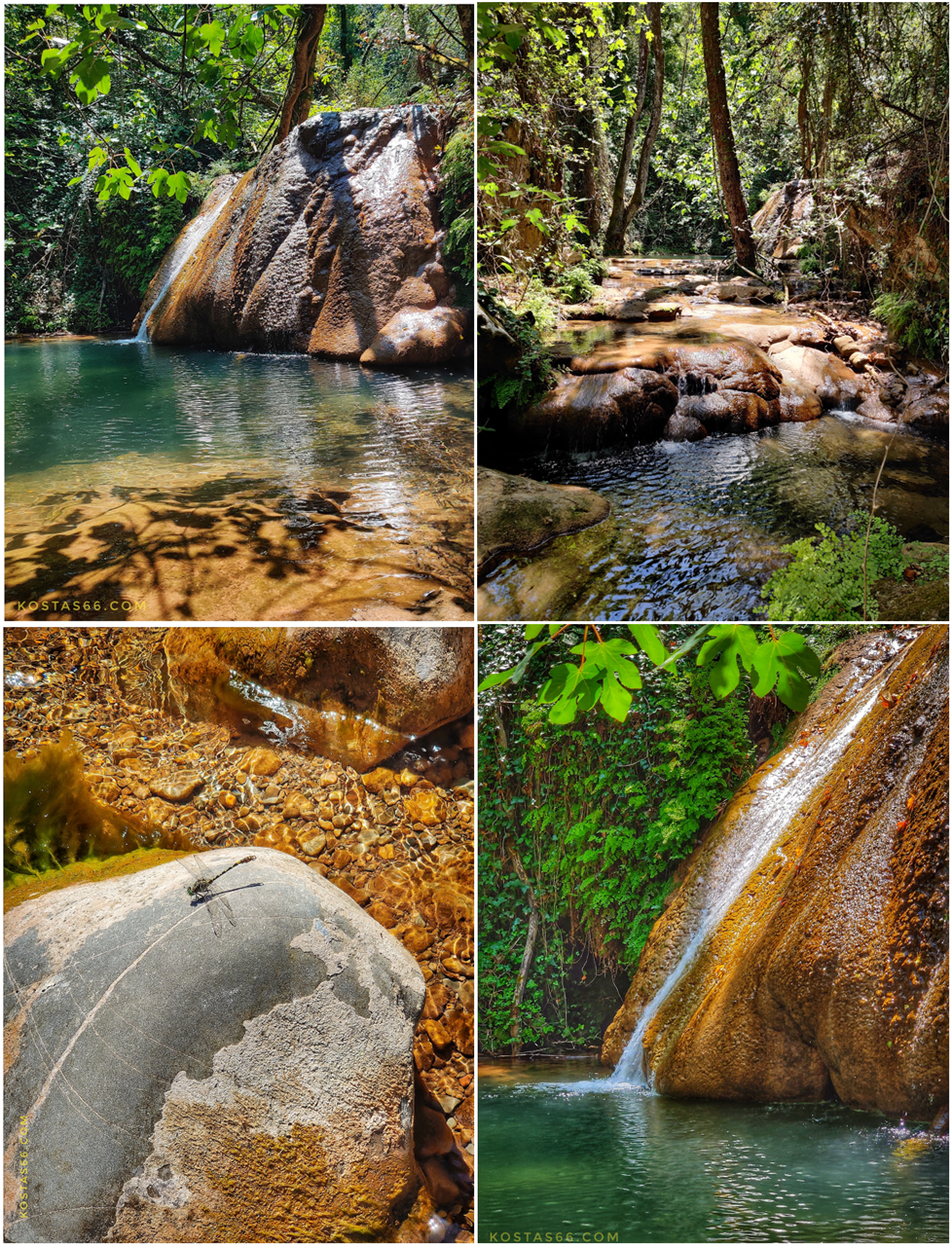GORTYNIA
The Heart of the Peloponnese
(summer 2020)
Dimitsana is the most known and beautiful town of the area.
Orientation
Gortynia (Γορτυνία) is a province of the Arcadian (Αρκαδία) prefecture, in the very middle of Peloponnese, which took its name from the city of Ancient Gortys.
The area is of exceptional natural beauty: high mountains covered with beautiful unspoiled forests, fertile little plateaus, stone-built bridges, wealthy villages with admirable mansions and elaborated bellfries, archeological sites and byzantine monasteries hanging on the edge of deep gorges, long trails and roaring rivers.
Gortynia on the map.
Typical gorge of the area.
Lousios (Λούσιος), Alfeios (Αλφειός) and Ladonas (Λάδωνας) are the three main rivers that cross the area creating deep gorges. No surprise that rafting is very popular in the area.
Mount Mainalo (Όρος Μαίναλο) is the main mountain of the region and its ski resort attracts many tourists during winter.
On the slopes of the deep gorge of Lousios River hang the byzantine monasteries: of Philosofou (Φιλοσόφου), of Agios Prodromos (John the Baptist) and of Aimialon (Αιμιαλών).
The well-preserved, stone-built villages, that were once supplying the emigrational wave, are now reborn and host masses of visitors in accommodations that combine tradition with modern standards.
The area is mainly a winter destination, but the beauty of the forests, the bloomed dales and the grazing lands is astonishing all year round.
For me, "an aficionado of cool weather" is an escape from the heat of a scorched summer country.
Dimitsana.
But, the main beauty of the area rests with the wealthy in architecture and beautifulness of its villages: Vytina, Dimitsana, Stemnitsa, Lagadia, Karytaina, Zatouna are some of the villages worth visiting.
Gortynia flora and fauna.
History basics.
During the antiquity the ancient Arcadian towns of Gortys, Tefthis, Helpousa and others grew up in the area.
During the 7th-8th centuries AD settled in the region Slavic tribes, which either abandoned the region in 807 AD, a year in which they were defeated by the Byzantine army, or were assimilated from the local Greek element. This is the reason of the existence, even today, several Slavic place names in the region.
In the 10th century AD the Orthodox monasticism was developed in the region, and in 963 AD Ioannis Lambardopoulos, Philosopher and Proclaimer of Byzantine Emperor Nikiphoros Fokas, founded the old Monastery of Panagia Philosofou, which is known in popular tradition as Krifo Scholio (underground or secret school).
Later, other monasteries were founded here, such as the Monastery of John the Baptist in the 12th century AD.
During the Frankish domination, there was an economic and cultural flourishing in the area, which was divided into two weights: of Akova and of Karytaina.
A painting of a Kleftis. After the revolution, the successful klaftes' contribution to it gave the occasion to change the meaning of the word kleftis (=thief). A romantic perception of the kleftes spread rapidly, linking them to the nationalist ideology through historians like Konstantinos Paparrigopoulos and Spyridon Trikoupis. In addition, many former kleftes have ascended to the upper ranks of the military, political and economic hierarchy of Greek society in the 19th century. Several of them in their memoirs embraced as patriotic their pre-revolutionary outlaw actions of the kleftes.
Anagnostis Stiftombolas, a hero of the Greek revolution. The statue is located at the main square of Levidi. Levidi is a beautiful town (close to Ancient Orchomenos), which could be considered as the gateway to Gortynia.
During the Ottoman domination, a big population fled from the lowlands and settled in the area because of its mountainous and inaccessible territory. Due to this particularity, several armed bodies of Kleftes (=thieves, illegal armed combatants) also acted in Gortynia.
The province, as well as the entire Peloponnese, passed into the possession of the Venetians in the period 1685-1715.
During the Orlof Revolt in 1770, Gortynia suffered looting from the Albanian troops of the Ottoman Empire, while similar was the disaster caused by Ibrahim Pasha in 1825, whose army burned several villages. During the Revolution of 1821, the region has led the way under the leadership of powerful families like Kolokotronaioi, Plapoutaioi and Deligiannaioi-Papagiannopoulaioi.
The area is scattered with monuments commemorating heroes, fighters and battles of the liberation struggle against the Οttoman Τurks. Thus, Gortinia dwells in every Greek’s heart.
All the places (yellow stars) I visited during this trip.
Vytina
From Athens to Vytina.
Vytina is located at an altitude of 1033m, in a verdant plateau on Mount Mainalo, dominated by pine, fir and chestnut trees. It is one of the most valued mountain resorts in the Peloponnese and more widely in Greece.
Based on Vytina, one can easily visit Dimitsana, the gorge of Lousios, Stemnitsa and Lagadia, while ascending the slopes of Mainalo on a good asphalt road one reaches the plateau of Ostrakina, at an altitude of 1600m, where there is a small ski resort center.
I stayed at "Archontiko Nikolopoulou", a renovated 19th century small mansion, with beautifully restored rooms and tasty breakfast, which you can enjoy at the courtyard. Recommended!
While in Vytina we watched a total eclipse of the moon (July 2018).
Beef cooked into tomato sauce and served with pasta.
Vytina (Βυτίνα) is the closest to Athens town (Levidi is closer, but it is not considered to be in Gortynia), some 180 km away. The roads are good, so one can reach the town in just over two hours. The closest city to Vytina is Tripolis (40 km), while the famous Ancient Olympia is only 80 km away on a reasonably good road, but with continuous turns at its first half part.
"Archontiko Nikolopoulou" is the little guest house, where I stayed in Vytina.
Here's the moon after the eclipse.
The town has several restaurants, cafés and shops with traditional products (artifacts made of wood, cheese, pasta, herbs, fruit, honey, etc), all located around the main square and the main road. We had dinner at two of the restaurants, “to Archontiko tis Athinas” (Το Αρχοντικό της Αθηνάς) and “Kokkina Pitharia” (Κόκκινα Πυθάρια), both next to the main square. This is a stockbreeder’s area, so most of the dishes use pork or beef: try the roasted piglet, the omelet with cured pork and the beef cooked into tomato sauce served with handmade lasagna.
The problem with food in the area is the quantity of salt they put into all dishes. Most probably it is what customers ask, but I believe the overdose of salt spoils food's taste. Oh well... I know I am strange...😀🤭
Langadia
Langadia (Λαγκάδια) is a traditional settlement situated on a mountainous area, at about 1000 m elevation. The National Road 74 (Pyrgos - Olympia - Tripoli) passes through the village and connects Langadia with Vytina, which is also located on this road, 23km to the east.
Langadia seen from the opposite side of the gorge..
Restaurant “Maniatis” is on the main road and has wonderful views of the gorge beneath. If you are lucky enough, you will get a seat at the two couches outside of café “In café”, where you can watch people pass by while enjoying your greek coffee.
From Vytina to Langadia it takes only 25 minutes on a good road.
The beautiful stone mansion on the ground floor of which operates "In Cafe".
Langadia used to be famous in Greece mainly for its builders, fine stone-craftsmen who made stone-built houses all over the Peloponnese peninsula, and especially in Mani.
Dimitsana (Δημητσάνα) is only 20km from Vytina. The road is very good and the landscape along the route rewarding. You can admire the wild beauty of the town approaching by car from the north: the road forms a bend just before entering into the town giving the visitor the opportunity to stop the car and enjoy the views. From this point you can also see the old three-arched stone bridge (under the new one that supports the main road to town), which once used to be the main entrance to the town for the visitors coming from the north.
Langadia.
Dimitsana seen from the road to Stemnitsa (south).
Dimitsana
Dimitsana seen from the road to Vytina (north).
The town is built on the ruins of an ancient town, which is supposed to be the town of Teuthis (Τεύθις) . Ancient Teuthis has participated in the Trojan War and was visited by the famous Greek traveler Pausanias in 174 AD who gives us valuable information about the city.
The story says that, during the war, the King of Teuthis (called by the same name) injured Goddess Athens with his spear. The Goddess punished him by giving him an incurable disease. Ruins of the ancient city walls are still preserved.
The town stands on a rocky slope (at an elevation of 950-1080 m) above the Lousios Gorge. From its southern side a marvelous view of Megalopolis plain and Mount Taygetus is provided. The closest cities to Dimitsana are Megalopolis and Tripolis.
The name of Dimitsana is probably Slavic like many other place names in the area and is related to the descent of the Slavs to the Peloponnese, which took place during the Byzantine Era of Greece.
Typical stone-paved road in Dimitsana.
Dimitsana seen from Zatouna (Profitis Elias chapel).
During the Greek Revolution of 1821, Dimitsana was an important supply center of gunpowder, which fueled the fighters of Peloponnese. Many residents were engaged in the production of gunpowder and the town had the largest warehouse, which is known as the "repository of the struggle for liberation". There are still around six powder mills saved in the area.
Greek 1930 postage stamp depicting Germanos III Metropolitan of Old Patras, who according to tradition, on March 25 1821, proclaimed the national uprising against the Ottoman Empire and blessed the flag of the revolution at the Monastery of Agia Lavra (close to the town of Kalavryta).
Dimitsana is the birthplace of two of the prominent figures of the Greek struggle against the Turks: a) Germanos III Metropolitan of Old Patras (who, according to tradition, on March 25 1821, proclaimed the national uprising against the Ottoman Empire and blessed the flag of the revolution at the Monastery of Agia Lavra) and b) Patriarch Gregory V of Constantinople (at the onset of the Greek War of Independence, as ethnarch of the Orthodox Millet, he was blamed by Ottoman Sultan Mahmud II for his inability to suppress the Greek uprising, and thus he was hung from the main gate of the Patriarchate). Both their houses can still be admired, while the Patriarch’s house accommodates the Ecclesiastical Museum.
Read more about the Monastery of Agia Lavra and the Greek Revolution of 1821 at this link:
The most prominent landmark of Dimitsana is the clock (ρολόι) located close to the center of the town market, next to the church of Agia Kyriaki. The magnificent tower holding the clock is made of fine marble and can be seen from afar. The clock was shipped from New York City in 1900. The foundation was set in 1928, and the tower was completed in 1934.
The statue of Patriarch Gregory V of Constantinople and Agia Kyriaki (top). The Dimitsana Library is located oposite the church of Agia Kyriaki (middle). Take a rest at the shadow of the big plane tree outside the Library (bottom).
The clock of Dimitsana.
The famous library of Dimitsana, which founded in 1764 by the monks Gerasimos Gounas and Agapios Leonardos, is located opposite the church of Agia Kyriaki. During the Ottoman domination, it was among the four libraries that existed in Greece and contained 5,000 volumes. It is housed in the beautiful building of the old Primary School (1845) at the location where the Dimitsana Ecclesiastical College used to be and from which many hierarchs graduated from in the years of Ottoman rule. The building combines elements of neoclassical style and the traditional architecture of mountainous Arcadia. During the Revolution of 1821, however, it suffered great damage, since much of its books were used in the manufacture of cartridges.
Today, of the old books survive about 700 volumes, including handwritten codes, 16th century books and a rich historical record. The library building also houses a folklore collection as well as an archaeological collection with findings from Ancient Teuthis. Among the exhibits there is the bronze larnax containing the bones of the Germanos III Metropolitan of Old Patras.
Dimitsana.
"Cafe Lousios" in Dimitsana.
Do not forget to try some of the Greek homemade pastries while visiting Dimitsana. "Cafe Lousios" on the main road (in the very center of the town) is a traditional beautiful cafe-patisserie with dark wood furnishing and marble round tables.
Cafe Lousios serves excellent Greek coffee and “galaktoboureko” (milk cream pie with filo pastry in syrop) in a fine old-style ambient environment. Check the cakes of the day and try them all! I had some nice “portokalopita” (orange pie with filo pastry).
Dimitsana
The Open-Air Waterway Museum (Υπαίθριο Μουσείο Υδροκίνησης) is located 2 km east of Dimitsana next to the church of Agios Ioannis. This is a place where, during the pre-industrial era, a large industrial complex powered by running water was operating.
Today, the complex is fully restored.
The church of Agios Ioannis.
Aimialon Monastery (Moni Emialon) and Open-Air Waterway Museum (Water Power Museum ) on the map.
Monastery of Panayia of Aimialon
Not far away from the Open-Air Waterways Museum, in the Gorge of Lousios river and in an impressive landscape, stands the Monastery of Panayia of Aimialon (Emialon - Παναγία Αιμυαλών), which has a guesthouse for travelers wishing to spend the night in the tranquility of the monastery. It is built at the foot of a rock in a fertile and green area, at an altitude of 900 meters. It is dedicated to the birth of the Virgin Mary.
The stairs taking you down to Aimialon Monastery.
Aimialon (Emialon) Monastery. The court of the Monastery.
The access to the Aimialon Monastery is easy: park your car at the parking lot outside the main gate and then descent some steps to reach the entrance of it. The entrance leads to a shady courtyard with beautiful flowers.
The view of the balcony of the archondariki (reception room, where coffee and cold water is offered to the visitors) is gorgeous.
With a stray dog outside the gate of Aimialon Monastery.
The monastery was built in 1600, perhaps on the ruins of another earlier monastery from the Byzantine period. The katholikon (church) of the monastery and its frescoes (hagiographies) were made in 1608 by the brothers Dimitrios and Georgios Moschos. Unfortunately, it is not allowed to take pictures in the church, unless you are fast and silent enough…😀🙂 Originally, the Monastery had the form of small hermitage with few monastic cells wedged into a cave. Of particular interest is the wood-carved iconostasis of the katholikon.
Zatouna
The katholikon entrance of the Aimialon Monastery.
The traditional settlement of Zatouna is built over the Lousios Gorge, 4 km west of Dimitsana. The picturesque Zatouna is amphitheatrically built according to the traditional local architecture at an altitude of 1,050 meters.
The village is small and quiet, the perfect place for relaxed holidays, and a real refuge during the hot summer months, because of its cool summer nights.
Zatouna.
The imposing stone church of Panagia Elovitissa (Dormition of Virgin Mary), built in 1853, dominates the beautiful central square of the village. Next to it stands the stone building of the elementary school (now Mikis Theodorakis Museum), where young students once learned their first letters, read their first words, and dreamt about life.
It is also worth visiting the little church of Agios Georgios with its impressive stone bell-clock tower (the main road separates the church from the bell tower) next to the recently renovated and turned into a hotel, Archontiko Anyfanti.
Zatouna. Panagia Elovitissa and the Elementary school (top).
During my July 2020 visit of the area I stayed at "Archontiko Anyfanti". To be more precise, I decided to visit the area because of the Archontiko itself: last time I was in Zatouna I saw this beautiful traditional hotel and thought it would be nice to stay here next time...so, I did.
The hotel is situated on the ex-Anyfanti residence. It used to be a typical wealthy Arcadian mansion of the 1840’s and it sets itself as an example of the local architecture. On the ground floor, there used to be the weaving business of the family and a textiles shop. On the back yard they used to paint the textiles and fabrics whilst on the entresol and floor it was the family’s house. During the years of the Greek War of Independence in 1821, the ground floor was used as a storage space for saltpeter that was supplied to the locals of Dimitsana to produce gunpowder. The building has been fully restored according to its original plans and has been converted into a hotel by the Greek architect Giannis Kizis. Elements such as the well-designed quoins, the fortress-like windows, the stone dome on the ground floor, the wooden balconies and the wooden ceilings with local patterns and designs will most definitely introduce you to the Arcadian architectural style. The building is regarded as a local treasure.
The hotel is managed by a wonderful young couple, who are ready to give you any info for the area and arrange activities you may fancy take. The lady was so nice to open (just for us) the museum dedicated to the famous music composer Mikis Theodorakis, which is housed in the old elementary school building next door.
The Mikis Theodorakis museum in Zatouna.
The museum aims to preserve the symbolism that is inherent in Zatouna, where the exiled and displaced musician, although imprisoned, continued thinking freely, inspiring and creating monumental works that preserve the message of freedom, transmit it to the next generations, and motivate them to engage in fertile interventions in the important social issues of our time.
During the liberation struggle of 1821, Zatouna brought out remarkable historical figures, fighters and many eminent clergymen. In more recent years, Zatuna, being isolated and on high grounds, served as a place of exile. From August 1968 till October 1969, the famous music composer Mikis Theodorakis was displaced here by the Junta regime (dictatorship). During his exile in the village, he was inspired and wrote his work "Arcadies" and the music of Kosta Gavra’s film “Z” with Yves Montand in the leading role.
Mikis Theodorakis - Arcadia I, VII, VIII. Full album.
The Soundrack of the film "Z" with Yves Montand, Irene Papas and Jean Louis Trintignant.
There are two restaurants in the village: "Ou Mplexeis" (Ού Μπλέξεις) and "Margarita" (Μαργαρίτα). "Ou Mplexeis" is a café-restaurant, and it is the modern choice, as it serves dishes one typically finds in a city restaurant, and also coffees and drinks till midnight. It is a small but lovely place, which during summer serves also out at the 3-4 tables stand by the road. Food is reasonably good, but not excellent. "Margarita" is a taverna, which serves rather traditional dishes. I do not have a personal opinion about “Margarita”, as I did not have any lunch there.
"Ού Μπλέξεις" cafe-restaurant.
Markos
A tasty beetroot salad at Ού Μπλέξεις.
5 kilometers south of Zatouna lies a small village called Markos (Μάρκος). In the middle of the village stands the square of the village and two buildings on it: the church and the old primary school (they stand one opposite to the other, leaving a big open space between the two of them).
Very recently, the old school building was renovated and now houses, besides the village "assembly room", a restaurant. "Scholeio" restaurant (the word for school in Greek) serves a few but very tasty dishes. During summer you are served outside in the square. The square, though, is where all villagers gather in the evenings to see each other and chat about everyday life. This is the astonishing thing about this place: you sit at your table to have your lunch/dinner and around you there are little children playing, teenagers looking at their smartphones and old people chatting loudly across the square! It really felt to me like a play staged at an open Greek theater, with us in the middle of the stage as the performers and the villagers as the noisy audience.
"Scholeio" restaurant at Markos village.
Panagia
Less than 10km southwest of Zatouna stands one of the many little villages of the area: Panagia (Παναγιά). At the village square there is supposed to be one of the best taverns in Peloponnese. It is called Tevarna Zerzova (the old, Slavic name of the village itself) and has a shady little yard, where one can escape from the summer heat. As I wanted to check this place and see why it is so famous, I ordered several dishes. I must admit that I was disappointed because the food was overcooked and heavy, especially for the summer. The wild boar was dry, the green beans were harvested after their time and were chewy, and the mushrooms had too much red pepper and vinegar.
Taverna Zerzova.
Eating at Taverna Zerzova. From left to right: wild boar and pasta, zucchini stew, green beans in olive oil and mushrooms with red pepper and vinegar.
River Alfeios
River Alfeios (Αλφειός) is the longest river in the Peloponnese. The river is 110 kilometres long, flowing through the regional units of Arcadia and Elis. Its source is near the village Dorizas, about halfway between Tripoli and Megalopoli in the highlands of Arcadia. It flows southwest toward Megalopoli, where it has been diverted around open pit lignite mines. At Thoknia it receives its right tributary Elissonas and continues north towards Karytaina. Below Karytaina River Lousios flows into the Alfeios, and the Alfeios continues northwest, passing north of Andritsaina. Near Tripotamia the rivers Ladon and Erymanthos flow into the Alfeios. The Alfeios then flows west along Olympia and empties into the Ionian Sea south of Pyrgos.
In Greek mythology, the Pineios and Alfeios were two rivers re-routed by Heracles in his fifth labour in order to clean the filth from the Augean Stables in a single day, a task which had been presumed to be impossible.
According to Greek mythology, the Arcadian nymph Arethusa (Αρέθουσα), a handmaiden of goddess Artemis (Diana) and the patron figure of ancient Syracuse, fled underwater through the Ionian Sea from Greece to Sicily. She wanted to escape the persistent advances of Alfeios, God of Rivers, who was madly in love with her. Arethusa asked Artemis for help and the goddess transformed her into the freshwater spring we see today. Alfeios left his home in Peloponnese and followed her. According to one legend, Alfeios is still looking for his beloved nymph, but according to another he finally located his love and mixed his waters with hers here at Fonte Aretusa (Arethusa Fountain) in Ortygia (Syracuse).
Fonte Aretusa (Arethusa Fountain) in Ortygia.
From Zatouna to Vrontou Waterfalls. P=car park, C=camp.
A nice spot to admire the river is just 18km south of Zatouna. From the top of the arched stone Cuckoo Bridge (Γεφύρι του Κούκου) one can admire the fast waters to run inside a gorge.
Drive 100m south of the bridge (at a sharp bend of the road) and leave your car to go down to the river and put your feet into the cold crystal-clear waters. Walk for another 150m and you see an open space with a big camping tent used by those exploring the area. Behind the tent there is short path to the river. Another path (on the right of the tent) leads to the beautiful Vrontos Waterfall (Καταρράκτης Βρόντου) that forms small ponds which reflect the green of the trees. There are picnic tables here for rest and having a snack. Do not forget to bring your own food and water of course.
Alfios River and the Cuckou Bridge.
Vrontos Waterfall.

